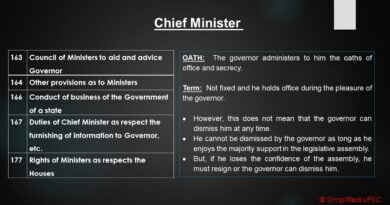Places of Worship Act, 1991
Context:
The Supreme Court on Friday asked the government to respond to a plea challenging a special law enacted in 1991 by the Congress government, which freezes the status of places of worship as it was on August 15, 1947.
About Worship Act 1991:
- It was passed in 1991 by the P V Narasimha Rao-led government.
- The law seeks to maintain the “religious character” of places of worship as it was in 1947 — except in the case of the Ram Janmabhoomi-Babri Masjid dispute, which was already in court.
- The law was brought in at the peak of the Ram Mandir movement, exactly a year before the demolition of the Babri Masjid.
- Introducing the law, then Home Minister S B Chavan said in Parliament that it was adopted to curb communal tension.
Provisions In Act:
- It aims to provide for the maintenance of the religious character of any place of worship as it existed on the 15th day of August 1947, and for matters connected therewith or incidental thereto”.
- Sections 3 and 4 of the Act declared that the religious character of a place of worship shall continue to be the same as it was on August 15, 1947.
- No person shall convert any place of worship of any religious denomination into one of a different denomination or section.
- Section 4(2) says that all suits, appeals or others regarding converting the character of a place of worship, that was pending on August 15, 1947, will stand abated when the Act commences and no fresh proceedings can be filed.
- However, legal proceedings can be initiated after the commencement of the Act if the change of status took place after the cut-off date of August 15, 1947.
Exemption:
- The disputed site at Ayodhya was exempted from the Act. Due to this exemption, the trial in the Ayodhya case proceeded even after the enforcement of this law.
- Besides the Ayodhya dispute, the Act also exempted:
- Any place of worship which is an ancient and historical monument or an archaeological site covered by the Ancient Monuments and Archaeological Sites and Remains Act, 1958.
- A suit that has been finally settled or disposed of.
- Any dispute that has been settled by the parties or conversion of any place that took place by acquiescence before the Act commenced.
- Besides the Ayodhya dispute, the Act also exempted:
Penalty:
- Section 6 of the Act prescribes a punishment of maximum three-years imprisonment along with a fine for contravening the provisions of the Act.
- Supreme Court’s View (in 2019):
- In the 2019 Ayodhya verdict, the Constitution Bench referred to the law and said it manifests the secular values of the Constitution and strictly prohibits retrogression.
Petition Arguments:
- It has been challenged on the ground that the Act violates secularism.
- It has been argued that the cut-off date of 15th August, 1947 is “arbitrary, irrational and retrospective” and prohibits Hindus, Jains, Buddhists, and Sikhs from approaching courts to “reclaim” their places of worship which were “invaded” and “encroached” upon by “fundamentalist barbaric invaders”.
- It is argued that the Centre has no power to legislate on “pilgrimages” or “burial grounds” which is under the state list.
- However, the government had said it could make use of its residuary power under Entry 97 of the Union List to enact this law.
- Entry 97 confers residuary powers to the Centre to legislate on subjects that are not enumerated in any of the three lists.
Discover more from Simplified UPSC
Subscribe to get the latest posts sent to your email.



